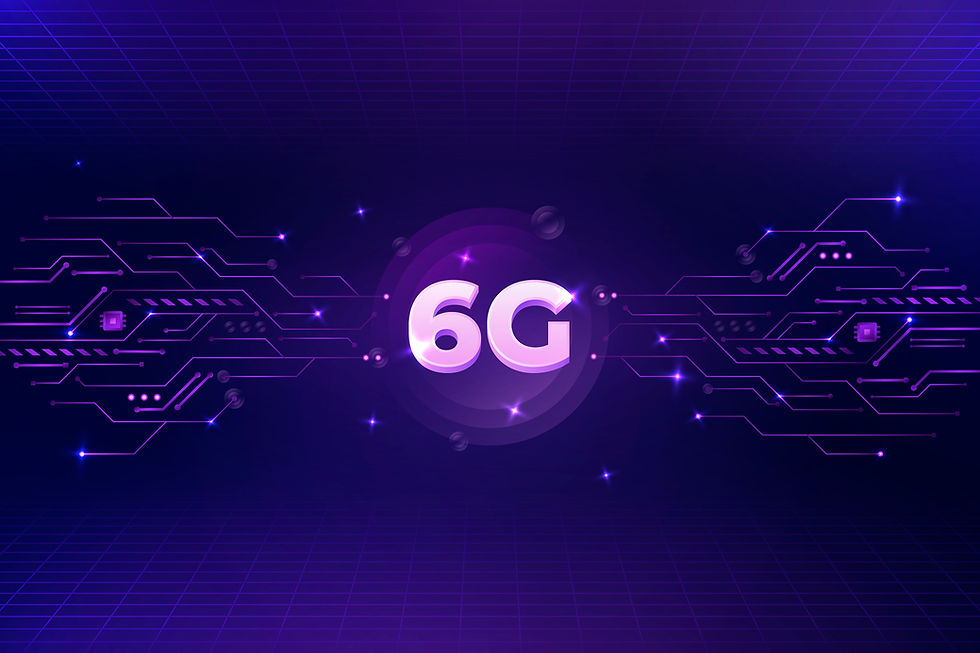Visible Light Communication (VLC) systems: AI driven health monitoring sets new standard for 6G Hospital Networks
- Lloyd Price
- May 26
- 6 min read

Visible Light Communication (VLC) systems: AI-driven health monitoring sets new standard for 6G hospital networks
Visible Light Communication (VLC) systems, combined with AI-driven health monitoring, are establishing a new benchmark for 6G hospital networks by delivering secure, high-speed, and scalable solutions tailored to healthcare’s unique demands. This convergence addresses critical challenges in patient care and hospital operations while offering HealthTech venture capitalists (VCs) compelling opportunities for exits in a challenging liquidity environment.
How VLC and AI Set a New Standard for 6G Hospital Networks
1. Real-Time, High-Precision Health Monitoring
VLC Contribution: VLC uses LEDs to transmit data from wearable medical sensors (e.g., monitoring heart rate, ECG, or PPG signals) at speeds up to 15.26 Gbps. Its electromagnetic interference (EMI)-free nature ensures no disruption to sensitive hospital equipment, unlike RF-based systems like Wi-Fi.
AI Role: AI algorithms, such as Long Short-Term Memory (LSTM) models and Q-learning, mitigate signal fluctuations caused by patient mobility. LSTM predicts channel conditions (e.g., path loss, RMS delay spread), while Q-learning dynamically adjusts modulation to maintain target symbol error rates (SERs), ensuring reliable data transmission.
6G Advantage: 6G’s ultra-low latency (<1 ms) and high bandwidth (up to 1 Tbps) enable real-time analytics for critical applications like telesurgery, remote diagnostics, or continuous ICU monitoring.
Impact: Enables instant detection of health anomalies (e.g., arrhythmias), improving patient outcomes and operational efficiency. For example, real-time ECG data transmitted via VLC can trigger immediate alerts for clinical intervention.
2. Enhanced Security and Privacy
VLC Contribution: VLC’s line-of-sight propagation limits signal leakage, reducing the risk of unauthorised access compared to RF systems, which is critical in healthcare’s privacy-sensitive environment.
AI Role: Federated Learning (FL) enables local AI model training on patient devices, minimizing data transmission and ensuring compliance with regulations like HIPAA. This reduces the need for centralised data storage, lowering privacy risks.
6G Advantage: 6G’s advanced encryption and network slicing create isolated, secure data channels for different hospital functions (e.g., patient monitoring vs. administrative systems).
Impact: Builds trust in digital health platforms, encouraging adoption by hospitals and patients. Secure systems are a key selling point for healthcare providers seeking regulatory-compliant solutions.
3. Cost-Effective and Scalable Infrastructure
VLC Contribution: VLC leverages existing LED lighting infrastructure, significantly reducing deployment costs for hospital networks. Hybrid systems combining VLC with power line communication (PLC) or 60 GHz mmWave backhaul enhance connectivity for high-capacity applications.
AI Role: Reinforcement learning (e.g., Q-learning) optimises resource allocation and modulation, enabling VLC to handle massive IoT device connections (e.g., thousands of sensors in a hospital).
6G Advantage: 6G’s massive machine-type communications (mMTC) support dense device networks, allowing seamless integration of sensors, wearables, and hospital systems.
Impact: Lowers financial and technical barriers to adoption, making VLC-based solutions scalable across hospitals of varying sizes. This scalability is critical for widespread market penetration.
4. Precise Indoor Localisation and Tracking
VLC Contribution: VLC enables high-precision indoor positioning, achieving mean position errors as low as 4.3 cm, ideal for tracking patients, staff, or equipment in complex hospital environments.
AI Role: Machine learning refines localisation algorithms, improving accuracy under dynamic conditions (e.g., moving patients or obstacles).
6G Advantage: 6G’s integrated sensing and communication (ISAC) capabilities enhance localization precision, complementing VLC’s strengths.
Impact: Streamlines hospital logistics, such as equipment management or patient flow, reducing costs and improving efficiency. For instance, tracking high-value assets like infusion pumps saves time and resources.
5. Alignment with 6G Healthcare Goals
VLC and AI Synergy: VLC’s high-speed, EMI-free communication, combined with AI’s ability to process complex, dynamic data, supports 6G’s requirements for ultra-reliable low-latency communication (URLLC) and intelligent networks.
Applications: Facilitates advanced healthcare use cases like telemedicine, electronic medical record integration, and AI-driven predictive diagnostics, positioning hospitals for 6G adoption by 2030.
Impact: Creates future-proof hospital networks capable of handling growing data demands and emerging technologies, ensuring long-term relevance.
Challenges and AI/VLC-Driven Solutions
Signal Reliability:
Challenge: Patient mobility or obstacles disrupt VLC’s line-of-sight signals, risking data loss.
Solution: AI techniques like LSTM-based channel estimation and Q-learning for adaptive modulation maintain performance by predicting and adjusting to signal changes.
Impact: Ensures continuous, reliable health monitoring, critical for hospital adoption.
Bandwidth Limitations:
Challenge: LEDs have limited modulation bandwidth, constraining data rates.
Solution: AI-driven signal processing (e.g., neural network-based post-equalization) and hybrid VLC-RF systems (e.g., with 60 GHz mmWave) enhance capacity.
Impact: Supports high-volume data applications like telemedicine, increasing market viability.
Adoption Barriers:
Challenge: Hospitals may hesitate due to integration costs or unfamiliarity with VLC.
Solution: VLC’s use of existing LED infrastructure and AI’s optimization of deployment reduce costs and complexity. Demonstrating compliance with healthcare standards further eases adoption.
Impact: Accelerates market penetration, enhancing startup appeal for exits.
Why This Sets a New Standard
The combination of VLC and AI in 6G hospital networks redefines healthcare connectivity by offering:
Unmatched Reliability: EMI-free VLC and AI-driven signal optimisation ensure robust, real-time data transmission for critical care.
Superior Security: VLC’s confined signals and AI’s federated learning meet stringent privacy requirements, fostering trust.
Scalability and Affordability: Leveraging existing infrastructure and AI-driven resource management lowers costs, enabling widespread adoption.
Future-Proof Innovation: Alignment with 6G’s URLLC, mMTC, and intelligent networking prepares hospitals for next-generation demands.
VLC systems, powered by AI-driven health monitoring, are setting a new standard for 6G hospital networks by delivering secure, reliable, and cost-effective connectivity tailored to healthcare’s needs. For HealthTech VCs, this convergence offers a pathway to navigate the exit landscape through strong market growth, regulatory alignment, and M&A potential. By backing startups leveraging VLC and AI, VCs can achieve profitable exits while addressing liquidity challenges, positioning themselves at the forefront of healthcare innovation as 6G networks emerge.

When can we expect 6G Hospital Networks?
While research and development for 6G are well underway, the widespread deployment of 6G hospital networks is still some years away. Here's a general timeline based on current industry expectations:
Early Research & Concept Development (2020-2025): This phase has largely been completed, with foundational research and initial concepts for 6G being established.
Prototyping and Standardization (2025-2030): This is the current phase we are in. Key milestones include:
3GPP Release 21 (targeted late 2028): This will be the first official 6G specification, laying the groundwork for how the technology will operate.
Pre-commercial trials (from 2028): We might see early trials and demonstrations of 6G systems in specific environments, including potentially some advanced healthcare scenarios, towards the latter part of this decade.
Initial Commercial Deployments (around 2030): The first commercial, standardised 6G networks are expected to go live in early-adopter countries around 2030.
Widespread Global Adoption and Integration (beyond 2030-2035): Large-scale global deployments and the full integration of 6G into various sectors, including healthcare, will likely occur after 2030, possibly extending to 2035 and beyond for full maturity.
Specific to Hospital Networks
While the general 6G timeline applies to hospitals, it's important to consider:
Complex Integration: Integrating a cutting-edge technology like 6G, especially with AI and VLC, into the complex and highly regulated healthcare environment will take time. This involves extensive testing, validation, and adherence to medical device standards.
Infrastructure Investment: Hospitals will need significant investment in new infrastructure to fully leverage 6G, including upgrading lighting for VLC, deploying new sensors, and implementing advanced data processing capabilities.
Regulatory Frameworks: New regulatory frameworks and standards for medical data transmission, security, and device interoperability under 6G will need to be developed and adopted.
In essence, while we are seeing research and initial prototypes for AI-driven VLC in healthcare now, a fully functional and widely adopted 6G hospital network, setting a "new standard," is most likely to be a reality in the early to mid-2030s
Nelson Advisors > Healthcare Technology M&A
.
Nelson Advisors specialise in mergers, acquisitions & partnerships for Digital Health, HealthTech, Health IT, Consumer HealthTech, Healthcare Cybersecurity, Healthcare AI companies based in the UK, Europe and North America. www.nelsonadvisors.co.uk
Nelson Advisors regularly publish Healthcare Technology thought leadership articles covering market insights, trends, analysis & predictions @ https://www.healthcare.digital
We share our views on the latest Healthcare Technology mergers, acquisitions & partnerships with insights, analysis and predictions in our LinkedIn Newsletter every week, subscribe today! https://lnkd.in/e5hTp_xb
Founders for Founders > We pride ourselves on our DNA as ‘HealthTech entrepreneurs advising HealthTech entrepreneurs.’ Nelson Advisors partner with entrepreneurs, boards and investors to maximise shareholder value and investment returns. www.nelsonadvisors.co.uk
#NelsonAdvisors #HealthTech #DigitalHealth #HealthIT #Cybersecurity #HealthcareAI #ConsumerHealthTech #Mergers #Acquisitions #Partnerships #Growth #Strategy #NHS #UK #Europe #USA #VentureCapital #PrivateEquity #Founders #BuySide #SellSide
Nelson Advisors LLP
Hale House, 76-78 Portland Place, Marylebone, London, W1B 1NT
Contact Us
Meet Us
Digital Health Rewired > 18-19th March 2025
NHS ConfedExpo > 11-12th June 2025
HLTH Europe > 16-19th June 2025




















































Comments